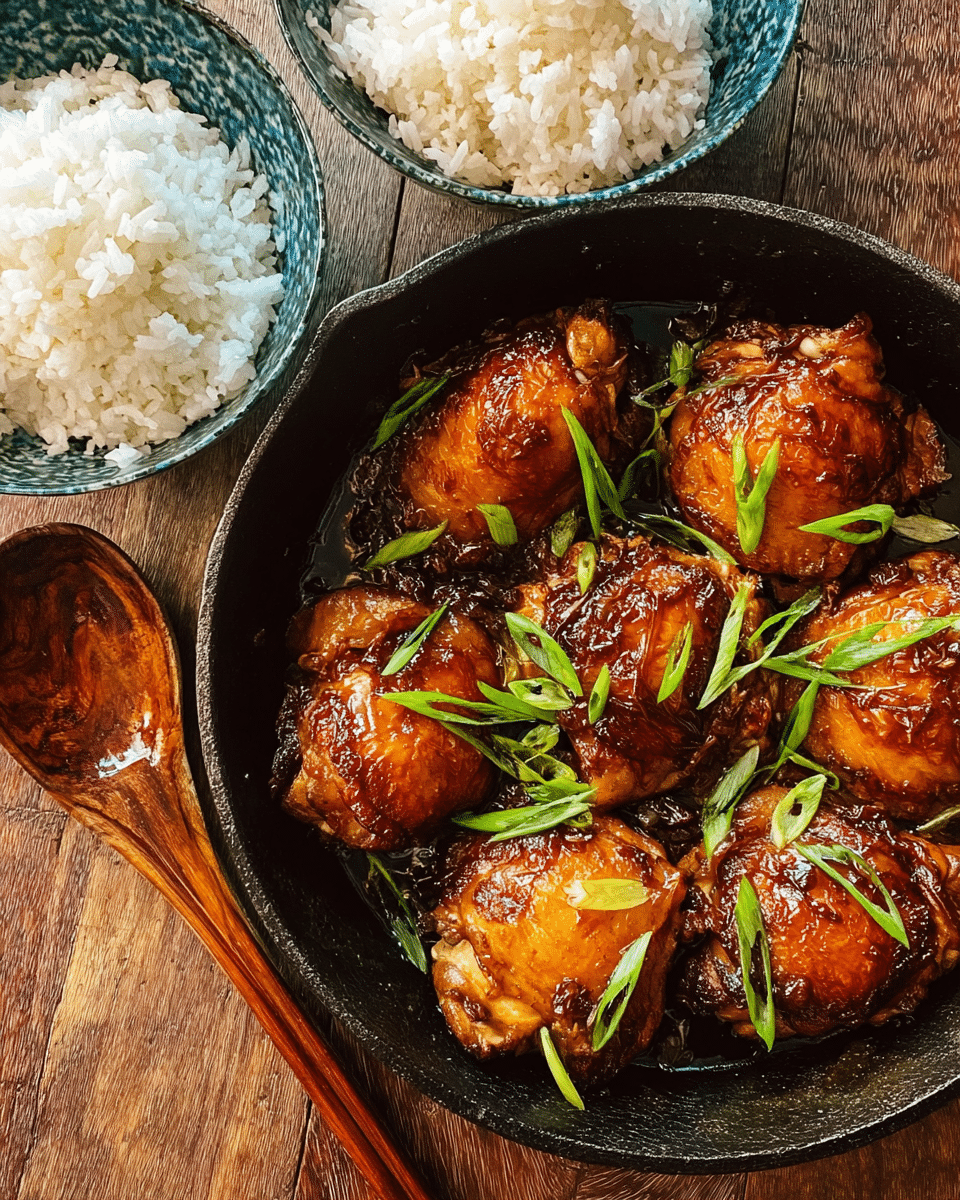This Chicken Adobo recipe from Tiffy Cooks is a classic Filipino dish made simple and accessible with one-pot convenience. It’s rich, savory, tangy, and slightly sweet—everything you want in a comforting chicken dinner. With tender, juicy chicken thighs simmered in a garlicky soy-vinegar sauce, this dish pairs perfectly with rice and is a guaranteed weeknight favorite.
Full Recipe:
Ingredients
-
6 pieces chicken thighs (bone-in, skin-on recommended)
-
1 whole onion, sliced
-
8 garlic cloves, minced
-
2 tbsp brown sugar
-
¼ cup vinegar
-
6 tbsp soy sauce
-
2½ tbsp dark soy sauce (optional, for color)
-
3 bay leaves
-
1–2 tbsp ground black pepper
-
¼ cup chicken stock
-
2 tsp whole black peppercorns
Directions
-
Sauté aromatics: Heat a pan over medium-high and drizzle in oil. Sauté sliced onions for 2–3 minutes, then add garlic and cook for another 1–2 minutes until fragrant.
-
Brown the chicken: Place chicken thighs skin-side down and sear for 3–5 minutes until golden.
-
Simmer: Add soy sauce, vinegar, brown sugar, dark soy sauce (if using), bay leaves, ground pepper, chicken stock, and peppercorns. Make sure all chicken is submerged.
-
Cover and cook: Put the lid on and simmer over medium-low for 15 minutes.
-
Reduce the sauce: Remove the lid, turn the heat to medium-high, and baste the chicken with sauce for another 5–7 minutes until slightly reduced and glossy.
-
Serve: Enjoy hot with steamed rice.
Nutrients
Per serving (serves 4):
-
Calories: 614 kcal
-
Protein: 45g
-
Fat: 40g
-
Saturated Fat: 11g
-
Carbohydrates: 17g
-
Sugar: 8g
-
Fiber: 2g
-
Sodium: 2349mg
-
Cholesterol: 237mg
-
Potassium: 726mg
-
Calcium: 72mg
-
Iron: 3mg
-
Vitamin A: 220 IU
-
Vitamin C: 4mg
A History Rooted in Tradition
Adobo’s origins can be traced back centuries, long before Spanish colonization introduced the term “adobo,” which means “to marinate” in Spanish. Indigenous Filipinos had long been preserving meat in vinegar and salt, a method that enhanced flavor while extending shelf life in the tropical climate. Over time, soy sauce replaced salt in many recipes, creating the iconic balance of salty and tangy notes that define the dish today. Chicken adobo, in particular, became popular due to the accessibility and affordability of chicken, making it a staple for families across the Philippines. This history adds cultural richness to every bite, reminding us that adobo is as much about heritage as it is about taste.
The Flavor Profile
At its core, Chicken Adobo is a masterclass in flavor harmony. Soy sauce lays the foundation with deep umami notes, while vinegar cuts through with tangy brightness. Garlic and onions infuse the dish with aroma and depth, while bay leaves add subtle earthiness. A touch of sugar balances the sharpness, rounding out the sauce with just the right amount of sweetness. Black pepper—both ground and whole—lends heat and complexity that lingers without overpowering. The chicken thighs absorb all these flavors, becoming tender and juicy as they simmer, creating a sauce that begs to be spooned over rice. The result is bold yet balanced, rich yet refreshing, savory yet slightly sweet.
The Beauty of One-Pot Cooking
In a world of busy schedules and endless responsibilities, one-pot meals have become kitchen heroes, and Chicken Adobo fits the bill perfectly. Everything—aromatics, chicken, sauce—cooks in the same vessel, allowing flavors to meld seamlessly while minimizing cleanup. The method is straightforward yet yields results that taste like they’ve been slow-cooked for hours. Searing the chicken first ensures a crisp skin and locks in juices, while simmering infuses every piece with flavor. Reducing the sauce at the end transforms it into a glossy glaze that clings to the chicken. It’s proof that simplicity doesn’t mean sacrificing flavor.
Perfect Pairing with Rice
No adobo experience is complete without a steaming plate of rice. The slightly tangy, garlicky sauce soaks into the grains, creating a combination that feels both comforting and indulgent. In Filipino households, it’s common to serve adobo with plain white rice, but it also pairs beautifully with garlic fried rice for extra depth. The rice balances the boldness of the sauce, ensuring each bite remains satisfying without being overwhelming. For many, this pairing represents the ultimate comfort meal—warm, filling, and nostalgic.
A Dish That Improves with Time
One of adobo’s unique qualities is that it tastes even better the next day. As the chicken continues to soak in the soy-vinegar sauce overnight, the flavors deepen, creating an even richer taste experience. This makes it an excellent meal-prep dish for busy households, as leftovers transform into something even more crave-worthy. Some even argue that adobo is best enjoyed reheated, as the sauce thickens slightly and the flavors become more concentrated. Few dishes can claim to improve with age, but adobo does so effortlessly.
Nutritional Perspective
Though indulgent in flavor, Chicken Adobo provides a nourishing balance of protein, fat, and carbohydrates when served with rice. The chicken thighs offer high-quality protein along with healthy fats that contribute to satiety. Garlic and onions provide antioxidants and immune-boosting properties, while vinegar adds acidity without extra calories. However, it is worth noting that soy sauce contributes a significant amount of sodium, so those mindful of salt intake may wish to adjust the quantity or use a low-sodium version. Overall, Chicken Adobo is hearty and satisfying, making it a fulfilling meal that offers both nutrition and comfort.
Global Popularity and Adaptations
While adobo is quintessentially Filipino, its popularity has spread worldwide thanks to its bold flavors and simple preparation. Variations have emerged across cultures and households—some use coconut milk for creaminess, others add chilies for spice, and a few swap chicken for pork, beef, or even vegetables. These adaptations reflect the versatility of adobo while showcasing its universal appeal. Food bloggers and chefs often highlight adobo as an entry point into Filipino cuisine, as it’s easy to make yet captures the complexity and soul of the country’s food culture.
Why Chicken Thighs Work Best
Although adobo can be made with various cuts of chicken, thighs—especially bone-in and skin-on—are ideal for this recipe. Their higher fat content ensures juiciness and flavor, while the bones enrich the sauce during cooking. The skin crisps during the initial sear, adding texture before becoming tender in the simmering sauce. The result is meat that falls off the bone yet remains flavorful and moist. While leaner cuts like chicken breast can be used, they may not provide the same richness that thighs naturally deliver.
A Dish That Brings People Together
Adobo is not just food—it’s a shared experience. Families often gather around steaming bowls, sharing stories and laughter while passing plates of rice and saucy chicken. In Filipino culture, it is a dish that symbolizes home, hospitality, and togetherness. Serving Chicken Adobo to guests is a gesture of warmth, a way of saying, “Welcome to my table.” Even outside the Philippines, this dish carries the same sense of connection, making it a powerful ambassador of culture through cuisine.
Conclusion
Chicken Adobo stands as one of the world’s most beloved comfort foods, offering a perfect blend of simplicity, flavor, and cultural heritage. Tiffy Cooks’ one-pot version makes it accessible for modern home kitchens while staying true to the heart of the dish. With tender chicken thighs bathed in a garlicky soy-vinegar sauce, it delivers bold taste in every bite and pairs perfectly with rice for a complete meal. Whether enjoyed fresh from the pot or reheated the next day, Chicken Adobo proves that some of the best recipes are also the most timeless. It’s more than just dinner—it’s a reminder of the power of food to nourish, connect, and comfort across cultures and generations.






